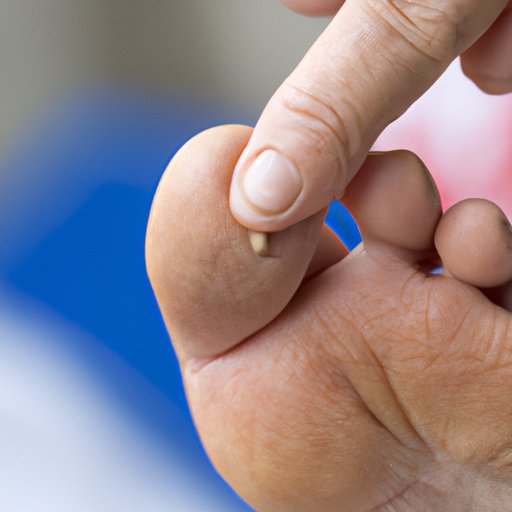
Introduction
Ingrown toenail is a painful condition that occurs when the toenail grows into the surrounding skin. This can cause swelling, redness, and even pus build-up leading to infection. It can also be caused by improper nail trimming or wearing ill-fitting shoes. Draining pus from an ingrown toenail is imperative to relieving the discomfort and preventing further infection. This article aims to provide readers with a step-by-step guide on how to drain pus from an ingrown toenail, home remedies for treating it, and tips to prevent it from recurring.
Step-by-Step Guide for Draining Pus from Ingrown Toenail
Draining pus from an ingrown toenail can be a straightforward process when done correctly. Here is a step-by-step guide to follow:
1. Begin by soaking your foot in warm water for 10-15 minutes to soften the nail and reduce pain.
2. Gently dry the affected area.
3. Using a sterilized pair of tweezers or a flat instrument, lift the edge of the nail that is digging into the skin.
4. Insert a small piece of sterile cotton or dental floss under the lifted nail edge to separate it from the skin.
5. Apply an antiseptic ointment or essential oil to the affected area to prevent further infection.
6. Cover the area with a bandage.
It is recommended to drain pus from an ingrown toenail before the infection spreads further. Ensure you follow all the steps carefully and do not attempt to perform this procedure if the infection is severe.
Home Remedies for Treating an Ingrown Toenail
In cases where there is minimal pus build-up, there are several home remedies that people can try to alleviate the discomfort and prevent infection. Here are a few home remedies worth trying:
1. Epsom salt soak: Soak your foot in warm water mixed with Epsom salt. This helps to soften the nails and prevent further infections.
2. Tea tree oil: Apply tea tree oil to the affected area to prevent the spread of the infection. This essential oil has natural antifungal and antiseptic properties.
3. Apple cider vinegar: Soak a cotton ball in apple cider vinegar and apply it to the affected area for 10-15 minutes. This helps to ease pain and reduces inflammation.
4. Baking soda: Mix baking soda and warm water to form a paste and apply it to the affected area. Rinse it off after 10-15 minutes. Baking soda helps to reduce inflammation and eliminates harmful bacteria.
Medical Intervention for Infected Ingrown Toenail
In severe cases of pus build-up, medical intervention is necessary. Here are some medical procedures that can be performed by medical professionals:
1. Partial nail removal: a minor surgery in which part of the ingrown toenail is removed.
2. Full toenail removal: in extreme situations, removal of the toenail is necessary to prevent further infection.
3. Antibiotics: medical experts may recommend oral or topical antibiotics to treat the infection.
It is recommended to seek medical attention if the condition worsens, and home remedies prove ineffective.
Prevention Methods for Ingrown Toenail
Prevention is always better than cure. Therefore, it is essential to take preventive measures to prevent ingrown toenail from recurring. Here are some practical tips that you can follow:
1. Ensure you wear comfortable shoes that fit well and offer smooth support to your feet.
2. Cut your nails straight across instead of rounding them off at the tip.
3. Take care while trimming toenails to avoid cutting them too short or causing damage.
4. Maintain good foot hygiene by washing feet regularly and keeping them dry and clean.
Personal Experiences and Lessons Learned
Many people who have suffered from ingrown toenail shared their experiences and insights. It is comforting to know that you’re not alone in this condition. Several people have successfully drained pus from their ingrown toenail using home remedies or seeking medical assistance. Individuals who have experienced ingrown toenail advise taking preventive measures to avoid future recurrence.
Conclusion
In summary, draining pus from an ingrown toenail can be a simple process that you can perform at home. However, in severe cases, medical intervention is necessary. It is essential to take preventive measures to prevent the condition from recurring. Home remedies are effective in reducing symptoms and keeping the infection in check. We hope that this article has provided readers with a step-by-step guide, home remedies, and preventive measures to manage ingrown toenail effectively. Remember that early intervention is key to preventing complications. If symptoms persist, seek medical assistance immediately.





